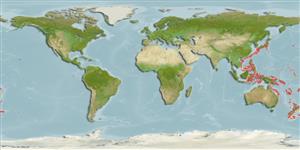Environment / Climate / Range
Ecology
Marine; bathydemersal; depth range 300 - 500 m (Ref. 9824). Deep-water, preferred ?
Western Pacific: southern Japan to the South China Sea and Taiwan.
Size / Weight / Age
Maturity: Lm ? range ? - ? cm
Max length : 20.0 cm SL male/unsexed; (Ref. 9824)
Dorsal
spines
(total): 0;
Dorsal
soft rays
(total): 109-125;
Anal
spines: 0;
Anal
soft rays: 90 - 101. Body elongate, its depth 2.8 to 3.3 times in SL., and head length 4.9 to 5.7 times in SL. Eyes separated by a bony ridge. Mouth small, about equal to eye diameter. Both jaws on ocular side with teeth.. First 2 dorsal fin rays not clearly separated from other rays.
Inhabits sand and mud bottoms. Marketed salt-dried.
Life cycle and mating behavior
Maturity | Reproduction | Spawning | Eggs | Fecundity | Larvae
Hensley, D.A. and K. Amaoka, 2001. Bothidae. Lefteye flounders. p. 3799-3841. In K.E. Carpenter and V. Niem (eds.) FAO species identification guide for fishery purposes. The living marine resources of the Western Central Pacific. Vol. 6. Bony fishes part 4 (Labridae to Latimeriidae), estuarine crocodiles. FAO, Rome. (Ref. 9824)
IUCN Red List Status (Ref. 115185)
CITES (Ref. 94142)
Not Evaluated
Threat to humans
Harmless
Human uses
Fisheries: commercial
More information
Common namesSynonymsMetabolismPredatorsEcotoxicologyReproductionMaturitySpawningFecundityEggsEgg development
ReferencesAquacultureAquaculture profileStrainsGeneticsAllele frequenciesHeritabilityDiseasesProcessingMass conversion
Tools
Special reports
Download XML
Internet sources
Estimates of some properties based on models
Phylogenetic diversity index (Ref.
82805): PD
50 = 1.0000 [Uniqueness, from 0.5 = low to 2.0 = high].
Bayesian length-weight: a=0.01023 (0.00442 - 0.02369), b=3.00 (2.81 - 3.19), in cm Total Length, based on LWR estimates for this (Sub)family-body shape (Ref.
93245).
Trophic Level (Ref.
69278): 3.6 ±0.4 se; Based on size and trophs of closest relatives
Resilience (Ref.
69278): Medium, minimum population doubling time 1.4 - 4.4 years (Assuming tmax>3).
Vulnerability (Ref.
59153): Moderate vulnerability (40 of 100) .
